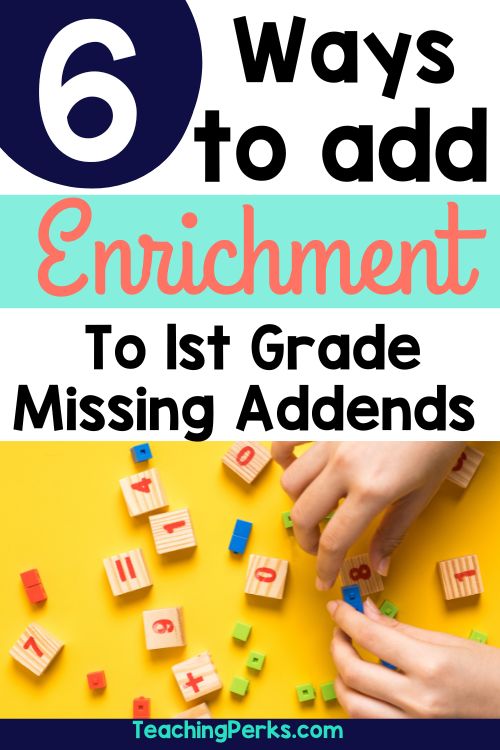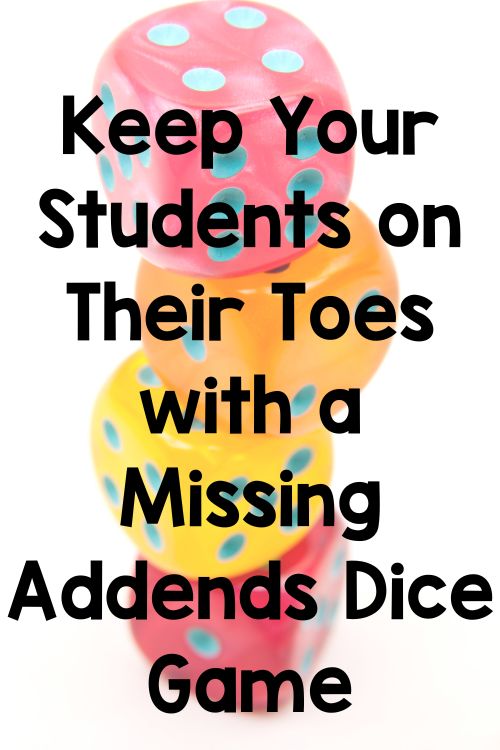Finding missing numbers in an equation can be a challenging task for many students, but some students will also master it quickly. When that happens, often times, teachers are left wondering how they can challenge these students. In this blog post, we will explore some enrichment activities and how they can be used to help students develop their math fluency and problem-solving skills.


Find Missing Numbers With Multiple Addends
This activity is designed to challenge students who have mastered finding the missing addend with two addends. Students will be presented with equations containing three or more addends and asked to find the missing addend in each equation.
For example, 7 + 3 + ___ = 15. This activity not only challenges students’ understanding of missing addends but also requires them to apply their knowledge of addition of 3 numbers.
You could differentiate even farther by asking students to show you more than one strategy to find the missing number. For this example, students can add 7 + 3 = 10 and then count on to 15 in order to get 5. They could also subtract 15 – 10 to get 5 as well.

Write Your Own Word Problems With Missing Numbers:
This activity challenges students to apply their understanding of missing addends in a creative way. Students will be asked to write their own word problems with missing addends and swap with classmates to solve.
For example, a student could write, “Samantha had 12 apples. She gave some to her friend and now has 9 apples. How many did she give away?” This activity not only challenges students to think creatively but also allows them to practice their writing skills.
For this activity, I like to give my students spinners that I create to help them write their word problem and to help make them silly and fun. One spinner will have characters such as a prince, bunny, clown, pirate, etc. The other spinner will have a setting such as baseball field, school, jungle, etc. They have to spin both and then create their word problem based on what they spin.

Missing Numbers Riddle
As a teacher, you can provide your students with a set of riddles that involve missing addends. For example, “I have three numbers: 5, 7, and ___. The sum of these three numbers is 18. What is the missing number?” or “I have four numbers: 2, 3, ___, and 6. The sum of these four numbers is 16. What is the missing number?” Students can work on these riddles individually or in pairs, and then share their answers with the class.
To make this activity more challenging, you can encourage your students to create their own riddles using missing addends, and then exchange them with their classmates and take turns solving them.

For example, “I am thinking of two numbers. One of them is 9 and the other is the missing addend that makes the sum equal to 17. What is the missing addend?” This not only helps to reinforce their understanding of missing addends but also promotes creativity and critical thinking skills.
Race to 50 With Missing Numbers
This game is a fun and interactive way to practice missing numbers while incorporating a bit of friendly competition. Students can work in pairs or small groups to play the game, taking turns rolling the dice and solving the missing addend problems.
For this game, the first student to reach 50 wins. Each player will roll a pair of dice and add the numbers together. Students must create an equation with missing numbers. For example, if a student rolls a 4 and a 6, they could write 4 + ___ = 10. The other player can then try to solve the equation and come up with the missing number, 6. The player that rolled the dice needs to check their answer.

Players take turns rolling and solving equations until one player reaches 50. So students must also add their missing numbers together after each turn to keep up with their score. So for the example above this player would have a score of 6 after their first turn. This activity not only helps students practice their addition skills but also encourages critical thinking and problem-solving.
To increase the level of difficulty, you can modify the game by requiring students to use more than two addends. Another way to make the game more challenging is to add a time limit, forcing students to think quickly and strategize their moves to reach 50 before their opponent.
Missing Numbers With Addition And Subtraction
Use equations that require both addition and subtraction, such as 6 + ___ – 2 = 9. Students will have to use their knowledge of both operations to determine the missing addend.
To solve this example, students would need to subtract 2 from 6 to get 4 and then count up from 4 to 9 to arrive at the answer 5.

Word Problems Involving Multiple Steps With Missing Numbers
Create word problems that involve multiple steps such as “Sarah spends $18 at the mall. She buys a shirt for $6 and a pair of shoes for $8. How much money did she spend on lunch?”
In this problem, the missing addend is the amount of money Sarah spent on lunch. To solve this problem, students will need to use their addition skills to find the total cost of the shirt and shoes, and then subtract that amount from the $18 that Sarah spent to find the missing addend.
By using a multi-step word problem with a missing addend, students can practice both their addition and subtraction skills while also developing their problem-solving abilities. This type of problem can be made even more or less challenging by including more or less items that were bought or increasing or decreasing the amounts spent.
Missing Numbers Conclusion
In conclusion, these activities provide students with fun and interactive ways to enhance their skills in finding missing numbers. By engaging in creative and challenging activities such as creating their own word problems, solving riddles, playing games, and tackling multi-step problems, students can not only improve their math fluency but also develop their problem-solving and critical thinking skills. With a variety of options available, teachers can choose activities that best suit their students’ needs and learning styles, and encourage them to approach math with enthusiasm and confidence.
Want missing number scripted lesson plans that are already written for you and include challenges, higher order thinking questions, games, independent practice pages and more? Check out this full unit on finding missing numbers and let me take the planning off your hands.

Leave a Reply